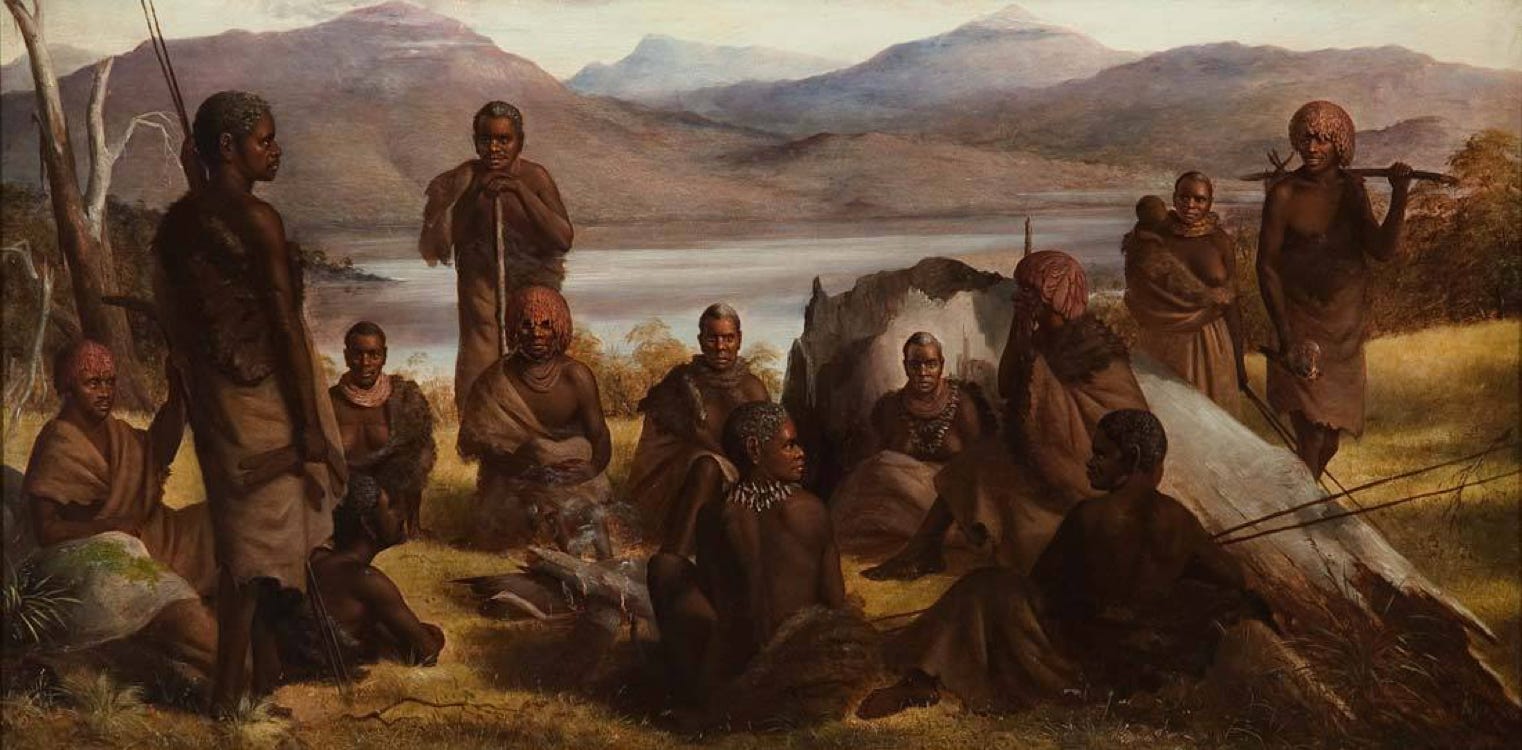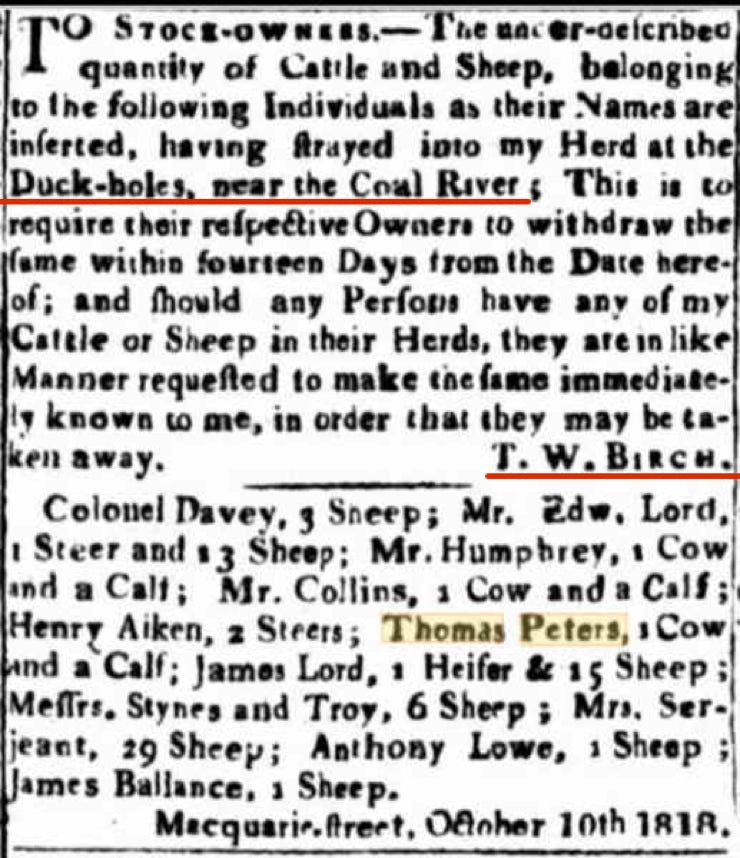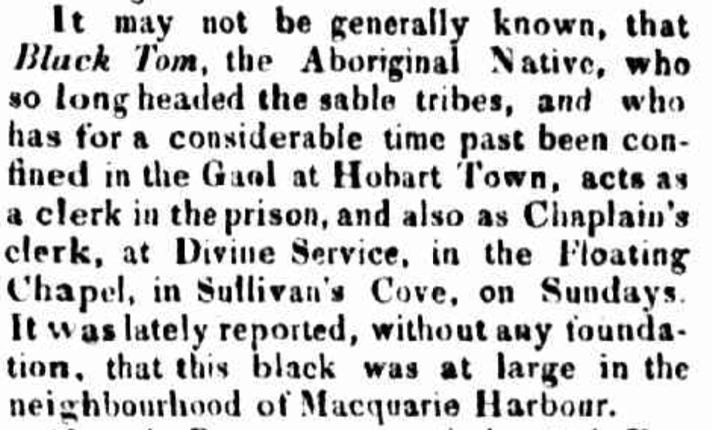Part B.
1818 Hobart: Stock on Birch’s land + Kickerterpoller & the Friendly Missions
HOBART 1818

Group of Natives of Tasmania, 1859. Robert Dowling ~ Via Wikimedia Commons

The Hobart Town Gazette and Southern Reporter
Sat 10 Oct 1818 Page 2 TROVE - National Library of Australia

Mr Robinson's first interview with Timmy , 1840, Benjamin Duterrau (1767 - 1851)
National Gallery of Australia, Canberra via Wikimedia Commons
…“Mr Robinson’s first interview with Timmy shows Robinson pursuing this work – a solitary white man surrounded by Aboriginal people. When Duterrau conceived this painting in 1834, he intended it as a tribute to Robinson’s success in peacefully persuading the Tasmanians to surrender after all the violence of the frontier. By 1840 when Duterrau completed it, approximately half the Tasmanian Aboriginal people who had been removed to Flinders Island as a result of Robinson’s work had died. Yet Duterrau continued to think of Robinson as a ‘real hero’.” - Tim Bonyhady in Anne Gray (ed), Australian art in the National Gallery of Australia, National Gallery of Australia, Canberra, 2002. via https://www.google.com/culturalinstitute/beta/
Thomas William Birch arrived in Hobart aboard the whaler, Dubuc in May 1808. On 12 September 1808, Thomas Birch married Sarah Guest (from Norfolk Island). In 1808 Thomas was one of three surgeons in Hobart Town but he moved into shipbuilding. He became involved in both the whaling and the sealing industry. He also established himself as a merchant in Macquarie Street. Records show that Thomas Birch owned land at Richmond, Hollow Tree, Jericho, Cambridge and Lovely Banks.
The newspaper advertisement (above) advising Thomas Peters and others that their stock have strayed into his herd, refers to Birch’s property at Duck Holes near the Coal River. This would have been his property he own at Richmond. At that time he had a young aboriginal named Kickerterpoller working on his land.
It is said that Birch had ‘somehow or other, acquired’* Kickerterpoller from his people, who were the Poredareme clan of the Oyster Bay nation (the Paredarerme), when he was about nine. Birch had him baptised, and set him to work as a farm hand. He became known as ‘Birch’s Tom’ and ‘Black Tom’. Gilbert Robertson, whose farm neighboured Birch’s Coal River farm, may have first come to know Kickerterpoller at this time. After Birch’s death in December 1821 Kickerterpoller returned to the Oyster Bay people for a time and was actively engaged in assaults on settlers in the southern midlands.
‘Over the summer of 1826–7 clans from the Big River, Oyster Bay and North Midlands nations speared a number of stock-keepers on farms and made it clear that they wanted the settlers and their sheep and cattle to move from their kangaroo hunting grounds. Settlers responded vigorously, resulting in many mass-killings, though this was poorly reported at the time. On 8 December 1826 a group led by Kickerterpoller threatened a farm overseer at Bank Hill farm at Orielton, near Richmond; the following day soldiers from the 40th Regiment killed 14 Aboriginal people from the Oyster Bay nation and captured and jailed another nine, including Kickerterpoller.’ https://en.wikipedia.org/wiki/Black_War
Gilbert Robertson, who had been Birch’s neighbour, was the Chief Constable at Richmond when Kickerterpoller was released. It was arranged that he went to live with Robertson and he acted as guide for his roving party. In 1829 Governor Arthur ordered that the five Aboriginals who were living with Gilbert Robertson were to be transferred to work as guides for George Augustus Robinson, who had been employed by Arthur to set up an Aboriginal establishment on Bruny Island.
‘Newspaper editor henry Melville reported a supposed conversation between Kickerterpoller and the Governor about this policy of confining Aborigines to an island. Kickerterpoller had put to Arthur the obvious question: You send him to dat hyland, and take’t all him own country. What you give him for him own country? The Governor sagaciously replied that he would give the Aboriginals food and blankets, and teach them to work.’ ~ Cassandra Pybus Till Apples Grow on an Orange Tree University of Queensland Press 1998 p 77
By the time Kickerterpoller was delivered to him, George Robinson had realized that the Bruny Island establishment had failed. On the 1 December 1829, Lieutenant-Governor George Arthur granted Robinson permission to organise an expedition to Port Davey on the south west coast. This was to be the first of the ‘Friendly Missions' in which he planned to inform the local tribes that Governor Arthur had humane intentions. “Governor Arthur promised Kickerterpoller a whaleboat as a payment for helping Robinson to make contact with the clanspeople in the bush, but it seems that this promise was never honoured. He married one of Robinson's Aboriginal guides, Pagerly, who accompanied him on Robinson's expeditions around the island.” # Robinson set out from Hobart with Kickerterpoller, and the ten survivors from Bruny Island on 28th January 1830. The party emerged at the coast in a state of exhaustion and starvation. Robinson then went up the west coast, arriving in Launceston in October. Meanwhile in late 1830, the colonial government organised a military operation known as the 'Black Line’. Thousands of men formed “a human chain across the settled districts, moving for three weeks south and east in a pincer movement, until the people were cornered on the Tasman Peninsula.” http://www.indigenousaustralia.info/land/invasion/tasmanian-land-war.html
In August 1831 Robinson records in his journal: ’This morning I developed my plans to the Chief Mannalargenna and explained to him the benevolent views of the government towards himself and his people …I informed him in the presence of Kickerterpoller that I was commissioned by the governor to inform them that if the natives would desist from their wonted outrages upon the whites, they would be allowed to remain in their respective districts and would have flour, tea and sugar, and clothes &c given them; that a good white man would dwell with them who would take care of them and would not allow any bad white man to shoot them, and he would go with them about the bush like myself and they then could hunt, He was much delighted.’ ~ Perkins, Rachel. & Langton, Marcia. First Australians The Miegunyah Press 2010 p.60.
In 1832 Robinson left Launceston on an expedition to the northwest coast. At the time ‘several of his guides were suffering from severe sickness. Kickerterpoller was one of three guides who became seriously ill and he was taken to a colonial homestead at Emu Bay to recuperate while Robinson and the rest of his troupe continued on their journey. He died from acute diarrhoea on 16 May 1832.’ # http://www.utas.edu.au/telling-places-in-country/historical-context/historical-biographies/kickerterpoller
Robinson’s ‘Friendly Missions' ‘ultimately led to the removal of the majority of the Aboriginal people from the mainland of Tasmania to the islands in the north east, and later to Oyster Cove. The removal is now a hotly contested subject, with Robinson's motives, role, and actions being much revisited and debated. In 1838 Robinson left Tasmania for Port Phillip, Victoria, where he was appointed the 'Chief Protector of Aborigines'. By 1849, however, the Protectorate system had failed. After a brief visit to Tasmania in 1851 (during which Robinson paid a final, disconcerting visit to the remaining Aborigines at Oyster Cove), he departed for his homeland.’ ~ Jacqui Darcy http://www.utas.edu.au/telling-places-in-country/historical-context/historical-background/robinsons-biography
See Also:
Australian Dictionary of Biography http://adb.anu.edu.au/biography/robinson-george-augustus-2596
Family Connections: 52 Ancestors #13 Thomas Birch. Blog entry for Monday, 17 March 2014 http://connectingthefamily.blogspot.com.au/2014/03/52-ancestors-13-thomas-birch.html
Fleetwood, Elizabeth. A Crying in the Wind http://tasmaniantimes.com/index.php?/article/a-crying-in-the-wind-...-toms-story/
Haebich, Anna. Broken Circles: Fragmenting Indigenous Families, 1800-2000 page 92
* Pybus, Cassandra. ‘A Self-Made Man’ in Reading Robinson: Companion Essays to George Robinson’s Friendly Mission http://books.publishing.monash.edu/apps/bookworm/view/Reading+Robinson%3A+Companion+Essays+to+George+Robinson%E2%80%99s+Friendly+Mission/176/OEBPS/c07.htm
Pybus, Cassandra. The Colourful Life of Gilbert Robertson 2011 http://launcestonhistory.org.au/wp-content/uploads/2012/03/CassandraPybus20112.pdf

Colonial Advocate, and Tasmanian Monthly Review and Register (Hobart Town, Tas. : 1828) Wed 1 Oct 1828
TROVE - National Library of Australia

The Tasmanian (Hobart Town, Tas. : 1827 - 1839)
Fri 7 May 1830 Page 7
TROVE - National Library of Australia
Research - Part B
29. RESEARCH Part B - A story of Thomas and Ann Peters.
30. RESEARCH Part B - Thomas Peters is transported for the term of his natural life
31. RESEARCH Part B - Mary Ann Peters accompanied her convict husband
32. RESEARCH Part B - 1803 Thomas, Mary Ann, & Elizabeth (2yrs) came to Port Phillip aboard the Calcutta
33. RESEARCH Part B - 1804 Peters family transferred to Van Diemen’s Land & Martha is born
34. RESEARCH Part B - 1805 Hobart Town: Mary Peters receives a Land Grant on New Town Rivulet
35. RESEARCH Part B - 1806 & 1807 The Peters have a farm with 4 cattle 2 sheep & a goat.
36. RESEARCH Part B - 1808 - 1812 Hobart Town: Martha dies, Thomas is pardoned, & 3 babies are born.
37. RESEARCH Part B - 1814 Hobart Town: Property deals, Horse races & a baby.
38. RESEARCH Part B - 1815 - 1816 Hobart Town: A juror, a boat race, supplying wheat & meat + 8th child
39. RESEARCH Part B - 1817 Hobart Town & York Plains: Thomas Peters receives a Land Grant
40. RESEARCH Part B - 1817 Hobart Town & Bagdad: the Duke of York & Baker’s farm
41. RESEARCH Part B - 1817 Hobart Town,York Plains, Bagdad & Tarrets’s farm
42. RESEARCH Part B - 1817 Hobart Town & Bagdad: Education, an executor, & stock moved from Herdsman’s Cove.
43. RESEARCH Part B - 1818 Hobart: A heavy cart and a ferry accident
44. RESEARCH Part B - 1818 Hobart: A court case, a house for sale. & Elizabeth marries George Armytage
45. RESEARCH Part B - 1818 Hobart: Stock on Birch’s land + Kickerterpoller & the Friendly Missions
46. RESEARCH Part B - 1819 Hobart: Rents to Supreme court & Mary Ann Peters (nee Hews) dies aged 39
47. RESEARCH Part B - 1819 - 1821 Hobart: Found guilty of ‘contumacious conduct in court’.
48. RESEARCH Part B - 1824 - 1829 Bagdad: Louisa marries John Hayes & Charlotte marries Francis Flexmore
49. RESEARCH Part B - 1830 Tasmania: The Black Line.
50. RESEARCH Part B - Nov 1930 Many Aborigines slip through the Black Line and the Peters house is raided.
51. RESEARCH Part B - 1830 Bagdad: As the Black Line advances settlers houses are attacked
52. RESEARCH Part B - 1830 Bagdad: Sophia Peters (16) and Ann Peters (14) are speared & Ann dies of her wounds.
53. RESEARCH Part B - 1830 - Following the Tasmania Wars the surviving traditional owners are rounded up
54. RESEARCH Part B - 1831 - 1839 Bagdad: Mary Ann Peters & Sophia Matilda Peters both got married,
55. RESEARCH Part B - 1839 Bagdad Thomas Peters dies
56. RESEARCH Part B - The 8 Children and 48 Grandchildren of Thomas & Mary Ann Peters
57. RESEARCH Part B - A Story of Thomas Peters and ‘the Brady Gang’
58. RESEARCH Part B - Where to next? Choices, choices, choices.

